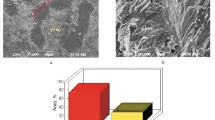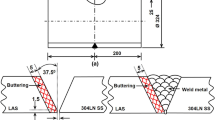Abstract
A mechanism of the structural and phase transformations in the contact zone upon the production of permanent joints during fusion welding of ferritic-pearlitic steels, which lead to the formation of a light band (LB) with a “silvery” stitched line in the middle, is proposed. It is shown that this effect is based on the phenomenon of local contact melting of cementite that had no time to be dissolved during the rapid heating (104 K/s) at the boundary with the adjacent high-carbon inhomogeneous austenite. This mechanism is proposed as an alternative to those suggested earlier in the last more than fifty years by some domestic and foreign researchers.
Similar content being viewed by others
References
S. I. Kuchuk-Yatsenko, Contact Flash Butt Welding (Naukova Dumka, Kiev, 1992) [in Russian].
L. I. Markashova, S. I. Grigorenko, G. K. Kharchenko, et al., “Structure of a Ferrite Band Formed in the Zone of Junction of Ferrite-Pearlite Steels upon Vacuum Pressure Welding,” Avtom. Svarka 566(5), 15–20 (2000).
A. S. Fal’kevich, “Conditions of the Formation and Properties of a Ferrite Band upon Pressure Welding,” Avtogen. Delo, No. 8, 8–12 (1951).
B. A. Forostovets, “Conditions of the Formation of a Light Band in Junctions Produced by Continuous Contact Butt Fusion Welding,” Avtom. Svarka 186(12), 18–22 (1968).
V. D. Taran and L. P. Skugorova, “Electron-Microscopic Study of Ferrite Bands in Joints of Main Pipelines,” Svar. Proizvod., No. 2, 12–15 (1961).
S. I. Kuchuk-Yatsenko, B. A. Forostovets, et al., “Welding by Continuous Flashing of Large-Section Articles from 34KhN1M Steel,” Avtom. Svarka 150(9), 8–12 (1965).
B. A. Forostovets and A. S. Dem’yanchuk, “Chemical Inhomogeneity of Junctions upon Contact Butt Welding of Steels of Large Section,” Avtom. Svarka, No. 6, 28–31 (1967).
A. V. Puiko, V. A. Zuboreva, I. P. Blinkova, et al., “Study of the Inhomogeneity of Welding Junctions Obtained by Butt Contact Fusion Welding,” in Problems of Welding Industry (Chelyab. Politekhn. Inst., Chelyabinsk, 1983), pp. 84–87 [in Russian].
J. Zak and P. Ryš, “The Origin on Light Area in Upset Welds of Rolled Carbon Steel,” Welding J. 51(5), 88–95 (1972).
G. K. Kharchenko, O. D. Smeyan, S. I. Kuchuk-Yatsenko, et al., “Behavior of High Carbon Steel upon Contact Butt Fusion Welding,” Vestn. Chernigov. Tekhnol. Univ., No. 37, 120–130 (2009).
L. N. Larikov, “Dislocation Pipe Diffusion. Encyclopedic Dictionary,” in Solid State Physics (Naukova Dumka, Kiev, 1996), Vol. 1 [in Russian].
D. S. Gertsriken, V. F. Mazanko, and V. M. Fal’chenko, Mass Transport in Metals at Low Temperatures (Naukova Dumka, Kiev, 1991) [in Russian].
D. S. Gertsriken, V. F. Mazanko, V. M. Tyshkevich, and V. M. Fal’chenko, Mass Transport under External Actions (RIO IMF, Kiev, 1999) [in Russian].
M. A. Krivoglaz and A. A. Smirnov, Theory of Order-Disorder in Alloys (Fizmatgiz, Moscow, 1958; American Elsevier, New York, 1964).
A. A. Smirnov, Generalized Theory of Alloy Ordering (Naukova Dumka, Kiev, 1986) [in Russian].
S. S. Shteinberg, Heat Treatment of Steel (Mashgiz, Sverdlovsk, 1950) [in Russian].
V. N. Gridnev, Yu. Ya. Meshkov, S. P. Oshkaderov, and V. N. Trefilov, Physical Foundations of Electrothermic Strengthening of Steel (Naukova Dumka, Kiev, 1973) [in Russian].
V. N. Gridnev, V. G. Gavrilyuk, Yu. Ya. Meshkov, and S. P. Oshkaderov, “To the Problem of Austenite Formation upon Electroheating of Hypereutectoid Steels,” in Phase Transformations in Metals and Alloys (Naukova Dumka, Kiev, 1965), pp. 64–71 [in Russian].
V. N. Gridnev, S. P. Oshkaderov, and R. V. Televich, “Austenite Transformation in Deformed Steel 30 upon Rapid Heating,” Fazov. Prevrashch., Ser. Metallofiz., No. 27 (Naukova Dumka, Kiev, 1970), pp. 79–83 [in Russian].
Yu. A. Garasim, I. Dlougi, and S. P. Oshkaderov, “Thermal Strengthening of High Strength Structural Steels with the Use of the Effect of Incomplete Homogenization,” Metallofiz. Noveishie Tekhnol. 25, 935–958 (2003).
K. P. Bunin, Iron-Carbon Alloys (Mashgiz, Moscow, 1949) [in Russian].
K. P. Bunin and Yu. N. Taran, Structure of Cast Iron (Metallurgizdat, Moscow, 1972) [in Russian].
Author information
Authors and Affiliations
Additional information
Original Russian Text © S.P. Oshkaderov, 2010, published in Fizika Metallov i Metallovedenie, 2010, Vol. 110, No. 6, pp. 583–589.
Rights and permissions
About this article
Cite this article
Oshkaderov, S.P. Structure formation in the joining zone of steels upon contact fusion welding. Phys. Metals Metallogr. 110, 557–563 (2010). https://doi.org/10.1134/S0031918X10120069
Received:
Accepted:
Published:
Issue Date:
DOI: https://doi.org/10.1134/S0031918X10120069




